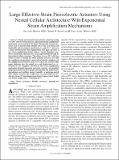Large effective-strain piezoelectric actuators using nested cellular architecture with exponential strain amplification mechanisms
Author(s)
Ueda, Jun; Secord, Thomas W.; Asada, Harry
DownloadAsada_Large effective-strain.pdf (1.005Mb)
OPEN_ACCESS_POLICY
Open Access Policy
Creative Commons Attribution-Noncommercial-Share Alike
Metadata
Show full item recordAbstract
Design and analysis of piezoelectric actuators having over 20% effective strain using an exponential strain amplification mechanism are presented in this paper. Piezoelectric ceramic material, such as lead zirconate titanate (PZT), has large stress and bandwidth, but its extremely small strain, i.e., only 0.1%, has been a major bottleneck for broad applications. This paper presents a new strain amplification design, called a “nested rhombus” multilayer mechanism, that increases strain exponentially through its hierarchical cellular structure. This allows for over 20% effective strain. In order to design the whole actuator structure, not only the compliance of piezoelectric material but also the compliance of the amplification structures needs to be taken into account. This paper addresses how the output force and displacement are attenuated by the compliance involved in the strain amplification mechanism through kinematic and static analysis. An insightful lumped parameter model is proposed to quantify the performance degradation and facilitate design tradeoffs. A prototype-nested PZT cellular actuator that weighs only 15 g has produced 21% effective strain (2.5 mm displacement from 12-mm actuator length and 30 mm width) and 1.7 N blocking force.
Date issued
2010-08Department
Massachusetts Institute of Technology. Department of Mechanical EngineeringJournal
IEEE/ASME Transactions on Mechatronics
Publisher
Institute of Electrical and Electronics Engineers
Citation
Ueda, J, T W Secord, and H H Asada. “Large Effective-Strain Piezoelectric Actuators Using Nested Cellular Architecture With Exponential Strain Amplification Mechanisms.” IEEE/ASME Transactions on Mechatronics 15.5 (2010): 770–782. Web.
Version: Author's final manuscript
Other identifiers
INSPEC Accession Number: 11450150
ISSN
1083-4435